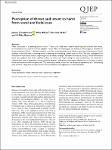Perception of threat and intent to harm from vocal and facial cues
| dc.contributor.author | Tompkinson, J | |
| dc.contributor.author | Mileva, Mila | |
| dc.contributor.author | Watt, D | |
| dc.contributor.author | Mike Burton, A | |
| dc.date.accessioned | 2023-05-04T15:04:04Z | |
| dc.date.available | 2023-05-04T15:04:04Z | |
| dc.date.issued | 2023-05-10 | |
| dc.identifier.issn | 1747-0218 | |
| dc.identifier.issn | 1747-0226 | |
| dc.identifier.uri | https://pearl.plymouth.ac.uk/handle/10026.1/20797 | |
| dc.description | File replaced (gold OA version) on 15.5.23 by NK (LDS) | |
| dc.description.abstract |
What constitutes a “threatening tone of voice”? There is currently little research exploring how listeners infer threat, or the intention to cause harm, from speakers’ voices. Here, we investigated the influence of key linguistic variables on these evaluations (Study 1). Results showed a trend for voices perceived to be lower in pitch, particularly those of male speakers, to be evaluated as sounding more threatening and conveying greater intent to harm. We next investigated the evaluation of multimodal stimuli comprising voices and faces varying in perceived dominance (Study 2). Visual information about the speaker’s face had a significant effect on threat and intent ratings. In both experiments, we observed a relatively low level of agreement among individual listeners’ evaluations, emphasising idiosyncrasy in the ways in which threat and intent-to-harm are perceived. This research provides a basis for the perceptual experience of a “threatening tone of voice,” along with an exploration of vocal and facial cue integration in social evaluation. | |
| dc.format.extent | 174702182311699-174702182311699 | |
| dc.format.medium | Print-Electronic | |
| dc.language | en | |
| dc.publisher | SAGE Publications | |
| dc.subject | Voice perception | |
| dc.subject | audiovisual integration | |
| dc.subject | intent to harm | |
| dc.subject | threat | |
| dc.title | Perception of threat and intent to harm from vocal and facial cues | |
| dc.type | journal-article | |
| dc.type | Journal Article | |
| plymouth.author-url | https://www.ncbi.nlm.nih.gov/pubmed/37020335 | |
| plymouth.publication-status | Published online | |
| plymouth.journal | Quarterly Journal of Experimental Psychology | |
| dc.identifier.doi | 10.1177/17470218231169952 | |
| plymouth.organisational-group | |Plymouth | |
| plymouth.organisational-group | |Plymouth|Faculty of Health | |
| plymouth.organisational-group | |Plymouth|Faculty of Health|School of Psychology | |
| plymouth.organisational-group | |Plymouth|REF 2021 Researchers by UoA | |
| plymouth.organisational-group | |Plymouth|Users by role | |
| plymouth.organisational-group | |Plymouth|Users by role|Academics | |
| plymouth.organisational-group | |Plymouth|REF 2021 Researchers by UoA|UoA04 Psychology, Psychiatry and Neuroscience | |
| plymouth.organisational-group | |Plymouth|REF 2021 Researchers by UoA|UoA04 Psychology, Psychiatry and Neuroscience|UoA04 Psychology, Psychiatry and Neuroscience MANUAL | |
| dc.publisher.place | England | |
| dcterms.dateAccepted | 2023-03-22 | |
| dc.date.updated | 2023-05-04T15:03:55Z | |
| dc.rights.embargodate | 2023-5-16 | |
| dc.identifier.eissn | 1747-0226 | |
| dc.rights.embargoperiod | forever | |
| rioxxterms.versionofrecord | 10.1177/17470218231169952 |


